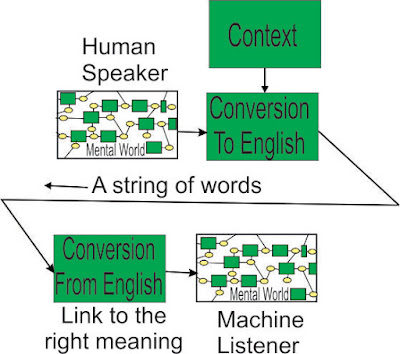What Will AGI Need to Know?
An AGI approach is needed for many applications, but not all require the Supreme version.
Legislation
Strong text understanding – some words, such as “reckless”
that don’t fit well in a program.
Linkage to other legislation – effectively a law library using Active
Structure.
Handling change over decades.
Some understanding of human behaviour
– Social Services - petty graft, such as a live-in boyfriend for
a woman who claims to live alone
- Money Laundering – a cost/benefit analysis of each of the different ways they
do business.
- Budget – better and more carefully integrated forecasting, rather than
conservative but wrong every year
Specifications
The need for strong linkage between text and photos or
diagrams.
Linkage to external systems.
Change over a long timeframe. Continuous checking for “problems down the line”.
Decisions on out-of-spec components.
Some understanding of the potential deviousness of suppliers.
Driving A Car
Driving a car is very much a dynamic problem – it is not
going to be handled well by static cognitive equipment, preprogrammed as though
the road is similar to a railway, with very limited special cases.
Adequate text and image handling to read road rules as a
means of familiarisation with the environment, and read road signs,
particularly ad hoc ones.
Visual and audio cues.
Basic Mechanics – velocity, acceleration, centrifugal force, variable traction
(wet road, sand, gravel, snow, ice), gradient.
Stopping distances, both for the vehicle being driven, and for vehicles in
front of and behind it.
Basic Control Response – steering wheel, accelerator, brakes, engine or motor
response, driver responses in other vehicles.
Hypothesising – a top level - “should I nip down the inside lane, even though
there is a car parked 200 metres away?”. At a lower level – monitoring of many
simultaneous potential threats.
Accelerated decision-making – traffic light changed to amber – already set up
calculation in anticipation, have half a second to decide whether to continue
or stop, Decision overridden if vehicles around it have different ideas.
Limited understanding of human behaviour – road manners, from a friendly wave
to aggressive tailgating, or active sabotaging, especially of autonomous trucks.
Peripheral road users – pedestrians, young children, cattle, pets.
This all sounds expensive. The alternative is being tethered
to the part of a city where behaviour is reliably predictable.
Bounded AGI – Regulations
Monitoring a system based on regulations – the Boeing 737
MAX MCAS fiasco as example. The system is given regulations relating to
commercial airliners – specifically those relating to the Flight Manual, and to
other relevant regulations. It observes the activity in the factory or the maintenance hangar, either preventing unauthorised work or checking
that the Flight Manual is updated whenever there is a change in how to fly the
aircraft. An auxiliary system checks systems against their specifications, and
the specifications against the regulations
Solving Problems Within A Budget
Good understanding of human behaviour.
Working with a handler, finding and solving problems within large organisations
– problems that are covered within a budget, and are expected to be solved, or
at least reduced in severity, when they are found.
Cannot take an “island” approach – fixing one problem shouldn’t make others
worse.
Open-Ended Problems
Excellent understanding of human attitudes and behaviour,
including their refractory nature and the timescales involved in changing them.
Ability to proceed without guidance.
Explanatory power. Handling of repeated rejection.
A typical problem would be Climate Change – a worldwide problem with huge obstacles
– people need to be convinced that their livelihoods should be abolished, or
they should flee the area, after many generations of living there.
One area that could benefit is that there are dozens of
different climate models – each affecting the overall picture but this is not
modelled – too complex. AGI could add a layer that handles the interactions
among the models, but it would be largely for show. It could attempt harm
minimisation when there is no appetite to face the problem head-on.


Comments
Post a Comment